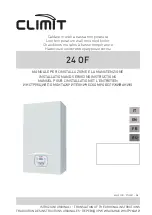
26
LP- 293 REV. 9.2.14
J. CHECK/CONTROL WATER CHEMISTRY
NOTE:
BOILER FAILURE DUE TO IMPROPER WATER CHEMISTRY IS NOT COVERED BY WARRANTY.
Sodium less than 20 mGL
Water pH between 6.0 and 8.0
1. Maintain boiler water pH between 6.0 and 8.0. Check with litmus paper or have chemically analyzed by water treatment company.
2. If pH differs from above, consult local water treatment company for treatment needed.
Hardness less than 7 grains
Consult local water treatment companies for unusually hard water areas (above 7 grains hardness).
Chlorine concentration less than 100 ppm
1. Filling with chlorinated fresh water should be acceptable since drinking water chlorine levels are typically less than 5 ppm.
2. Do not use the boiler to directly heat swimming pool or spa water.
3. Do not fill boiler or operate with water containing chlorine in excess of 100 ppm.
Hardness:
7 grains
Chloride levels:
100 ppm
pH levels:
6-8
TDS:
2000 ppm
Sodium:
20 mGL
Clean system to remove sediment*
1. You must thoroughly flush the system (without boiler connected) to remove sediment. The high-efficiency heat exchanger can be
damaged by buildup or corrosion due to sediment.
2. For zoned systems, flush each zone separately through a purge valve. (If purge valves and isolation valves are not already installed,
install them to properly clean the system.)
3. Flush system until water runs clean and you are sure piping is free of sediment.
*NOTE:
It is recommended you clean heat exchanger at least once a year to prevent lime scale buildup. Follow the maintenance
procedure to clean the heat exchanger in the Maintenance Section (Part 12 of this manual).
Test/replace freeze protection fluid
1.
For systems using freeze protection fluids, follow fluid manufacturer’s instructions to verify inhibitor level and that other fluid
characteristics are satisfactory.
2. Freeze protection fluid must be replaced periodically due to degradation of inhibitors over time. Follow all fluid manufacturer
instructions.
Piping components
Heating system piping:
Water boiler system piping MUST be sized per technical pipe requirements listed in Table 6 and Table 7. Reducing pipe size can
restrict flow rate through the water boiler, causing inadvertent short cycling and poor system performance.
Check valves:
Field supplied. Check valves are recommended for installation as shown in Piping Details.
Water boiler isolation valves:
Field supplied. Full port ball valves are required. Failure to use full port ball valves could result in a restricted flow rate through the water
boiler.
Mixing valve:
Field supplied. A mixing valve is recommended when storing domestic hot water above 115°F.
Unions:
Field supplied: Recommended for unit serviceability.
DO NOT USE DIELECTRIC UNIONS!
ONLY BRASS, COPPER, OR STAINLESS STEEL.
Summary of Contents for EL-110
Page 13: ...13 LP 293 REV 9 2 14 Figure 3 LP 285 B ...
Page 51: ...51 LP 293 REV 9 2 14 Figure 29 Cascade Master and Follower ...
Page 52: ...52 LP 293 REV 9 2 14 Figure 30 ...
Page 53: ...53 LP 293 REV 9 2 14 Figure 31 ...
Page 54: ...54 LP 293 REV 9 2 14 Figure 32 ...
Page 77: ...77 LP 293 REV 9 2 14 Figure 36 ...
Page 78: ...78 LP 293 REV 9 2 14 Figure 37 ...
Page 79: ...79 LP 293 REV 9 2 14 Figure 38 LP 293 A ...
Page 82: ...82 LP 293 REV 9 2 14 ...
Page 83: ...83 LP 293 REV 9 2 14 ...
















































